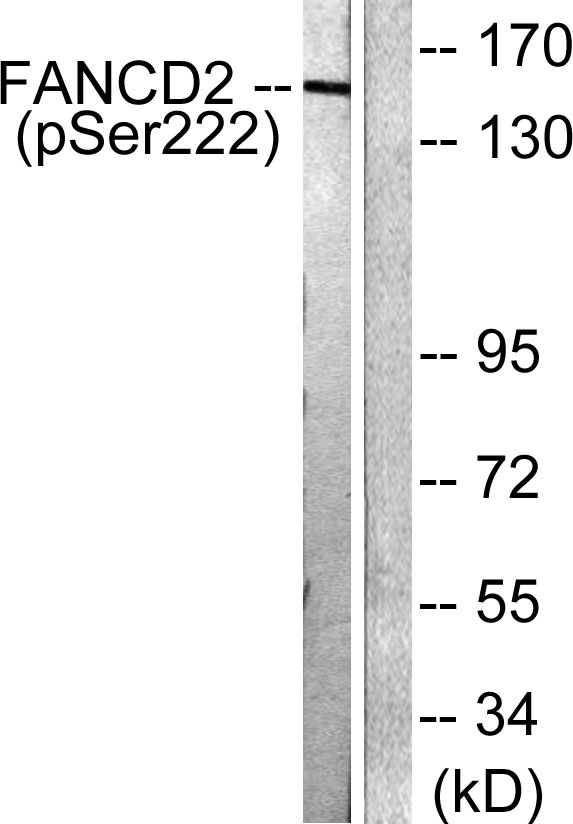产品名称
FANCD2 (phospho Ser222) Rabbit Polyclonal Antibody
别名
FANCD2; FACD; Fanconi anemia group D2 protein; Protein FACD2
蛋白名称
Fanconi anemia group D2 protein
存储缓冲液
Liquid in PBS containing 50% glycerol, 0.5% BSA and 0.02% New type preservative N.
Human Gene Link
http://www.ncbi.nlm.nih.gov/sites/entrez?db=gene&term=2177
Human Swissprot No.
Q9BXW9
Human Swissprot Link
http://www.uniprot.org/uniprotkb/Q9BXW9/entry
Mouse Gene Link
http://www.ncbi.nlm.nih.gov/sites/entrez?db=gene&term=211651
Mouse Swissprot No.
Q80V62
Mouse Swissprot Link
http://www.uniprot.org/uniprot/Q80V62
Rat Gene Link
http://www.ncbi.nlm.nih.gov/sites/entrez?db=gene&term=312641
Rat Swissprot Link
http://www.uniprot.org/uniprot/Q6IV68
免疫原
The antiserum was produced against synthesized peptide derived from human FANCD2 around the phosphorylation site of Ser222. AA range:188-237
特异性
Phospho-FANCD2 (S222) Polyclonal Antibody detects endogenous levels of FANCD2 protein only when phosphorylated at S222.
稀释度
WB 1:500 - 1:2000. IHC 1:100 - 1:300. ELISA: 1:5000.. IF 1:50-200
宿主
Polyclonal, Rabbit,IgG
背景介绍
Fanconi anemia complementation group D2(FANCD2) Homo sapiens The Fanconi anemia complementation group (FANC) currently includes FANCA, FANCB, FANCC, FANCD1 (also called BRCA2), FANCD2, FANCE, FANCF, FANCG, FANCI, FANCJ (also called BRIP1), FANCL, FANCM and FANCN (also called PALB2). The previously defined group FANCH is the same as FANCA. Fanconi anemia is a genetically heterogeneous recessive disorder characterized by cytogenetic instability, hypersensitivity to DNA crosslinking agents, increased chromosomal breakage, and defective DNA repair. The members of the Fanconi anemia complementation group do not share sequence similarity; they are related by their assembly into a common nuclear protein complex. This gene encodes the protein for complementation group D2. This protein is monoubiquinated in response to DNA damage, resulting in its localization to nuclear foci with other proteins (BRCA1 AND BRCA2) involved in homology-directed DNA repai
组织表达
Highly expressed in germinal center cells of the spleen, tonsil, and reactive lymph nodes, and in the proliferating basal layer of squamous epithelium of tonsil, esophagus, oropharynx, larynx and cervix. Expressed in cytotrophoblastic cells of the placenta and exocrine cells of the pancreas (at protein level). Highly expressed in testis, where expression is restricted to maturing spermatocytes.
细胞定位
Nucleus . Concentrates in nuclear foci during S phase and upon genotoxic stress. At the onset of mitosis, excluded from chromosomes and diffuses into the cytoplasm, returning to the nucleus at the end of cell division. Observed in a few spots localized in pairs on the sister chromatids of mitotic chromosome arms and not centromeres, one on each chromatids. These foci coincide with common fragile sites and could be sites of replication fork stalling. The foci are frequently interlinked through BLM-associated ultra-fine DNA bridges. Following aphidicolin treatment, targets chromatid gaps and breaks.
功能
developmental stage:Highly expressed in fetal oocytes, and in hematopoietic cells of the fetal liver and bone marrow (at protein level).,disease:Defects in FANCD2 are a cause of Fanconi anemia (FA) [MIM:227650]. FA is a genetically heterogeneous, autosomal recessive disorder characterized by progressive pancytopenia, a diverse assortment of congenital malformations, and a predisposition to the development of malignancies. At the cellular level it is associated with hypersensitivity to DNA-damaging agents, chromosomal instability (increased chromosome breakage), and defective DNA repair.,domain:The C-terminal 24 residues of isoform 2 are required for its function.,function:Required for maintenance of chromosomal stability. Promotes accurate and efficient pairing of homologs during meiosis. Involved in the repair of DNA double-strand breaks, both by homologous recombination and single-strand annealing. May participate in S phase and G2 phase checkpoint activation upon DNA damage. Promotes BRCA2/FANCD1 loading onto damaged chromatin. May also be involved in B-cell immunoglobulin isotype switching.,PTM:Monoubiquitinated on Lys-561 during S phase and upon genotoxic stress (isoform 1 and isoform 2). Deubiquitinated by USP1 as cells enter G2/M, or once DNA repair is completed. Monoubiquitination requires the FANCA-FANCB-FANCC-FANCE-FANCF-FANCG-FANCM complex, RPA1 and ATR, and is mediated by FANCL/PHF9. Ubiquitination is required for binding to chromatin, interaction with BRCA1 and BRCA2, DNA repair, and normal cell cycle progression, but not for phosphorylation on Ser-222 or interaction with MEN1.,PTM:Phosphorylated in response to various genotoxic stresses by ATM and/or ATR. Upon ionizing radiation, phosphorylated by ATM on Ser-222 and Ser-1404. Phosphorylation on Ser-222 is required for S-phase checkpoint activation, but not for ubiquitination, foci formation, or DNA repair. In contrast, phosphorylation by ATR on other sites may be required for ubiquitination and foci formation.,subcellular location:Concentrates in nuclear foci during S phase and upon genotoxic stress.,subunit:Interacts directly with FANCE and FANCI. Interacts with USP1 and MEN1. The ubiquitinated form specifically interacts with BRCA1, BRCA2 and BLM.,tissue specificity:Highly expressed in germinal center cells of the spleen, tonsil, and reactive lymph nodes, and in the proliferating basal layer of squamous epithelium of tonsil, esophagus, oropharynx, larynx and cervix. Expressed in cytotrophoblastic cells of the placenta and exocrine cells of the pancreas (at protein level). Highly expressed in testis, where expression is restricted to maturing spermatocytes.,
纯化
The antibody was affinity-purified from rabbit antiserum by affinity-chromatography using epitope-specific immunogen.


